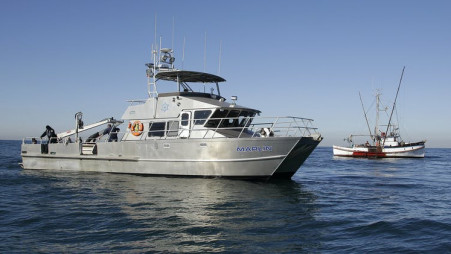AI, satellite data used to find forced labor in thousands of ocean fishing boats
This study showed that up to 100,000 individuals may have been victims of forced labour between 2012 and 2018 on these ships

Fishing on the high seas beyond the territorial jurisdiction of any nation are high-effort, low payoff fishing grounds and yet fishers continue to work in them which makes fishing on the high seas a bit of a mystery, according to The Conversation.
It was discovered in 2018 by the environmental data scientists at the Environmental Market Solutions Lab that high-seas fishing often is very unprofitable, even with government subsidies.
Even then, high seas are continued to be harvested in staggering numbers which suggest that the activity is financially supported beyond government subsidies.
This mystery – why so many vessels are fishing the high seas if it isn't profitable – got a team of environmental data scientists thinking that maybe many of these vessels are, in a sense, being subsidized through low labour costs. These costs could even be zero if the vessels were using forced labour.
In open fishing, forced labour is a known problem but historically, the scale has been quite hard to track.
By combining data science with satellite monitoring, input from human rights practitioners and machine learning algorithms, a way was developed to predict if a fishing vessel was at high risk of using forced labour.
This study showed that up to 100,000 individuals may have been victims of forced labour between 2012 and 2018 on these ships.
Forced labour is defined by the International Labour Organization as "all work or service which is exacted from any person under the menace of any penalty and for which the said person has not offered themself voluntarily." Essentially, many of these workers may be enslaved, unable to stop work, trapped out on the high seas. Sadly, forced labour has been widely documented in the fishing world, but the true extent of the problem has remained largely unknown.
So, the question was asked - what if vessels that forced labour behaved in observable, fundamentally different ways from vessels that do not?
To answer this, 22 vessels known to have used forced labour were observed.
The data was obtained from Global Fishing Watch – a nonprofit organization that promotes ocean sustainability using near-real-time fishing data – and used it to find commonalities in how these vessels behaved. To further inform what to look for in the satellite monitoring data, a number of human rights groups were consulted including Liberty Shared, Greenpeace and the Environmental Justice Foundation, to determine which of these vessel behaviours might indicate a potential risk of forced labour.
This list of indicators included vessel behaviours like spending more time on the high seas, travelling farther from ports than other vessels and fishing more hours per day than other boats. For example, sometimes these suspicious vessels would be at sea for many months at a time.
With a good idea of the "risky" behaviours that signal the potential use of forced labour, the scientists with the help of Google data scientists used machine learning techniques to look for similar behavioural patterns in thousands of other vessels.
They examined 16,000 fishing vessels using data from 2012 to 2018. Between 14% and 26% of those boats showed suspicious behaviour that suggests a high likelihood that they are exploiting forced labour. This means that in those six years, as many as 100,000 people may have been victims of forced labour. It could not be known whether those boats are still active or how many high-risk vessels there may be on the seas today. But according to Global Fishing Watch, as of 2018, there were nearly 13,000 vessels operating in industrial longliner, trawler and squid jigger fleets.
Squid jiggers lure their catch to the surface at night using bright lights; longliner boats trail a line with baited hooks, and trawlers pull fishing nets through the water behind them. Squid jiggers had the highest percentage of vessels that exhibited behaviours that indicate the potential use of forced labour, followed closely by longliner fishing vessels and, to a lesser extent, trawlers.
Another key finding from the study is that forced labour violations are likely occurring in all major ocean basins, both on the high seas and within national jurisdictions. High-risk vessels frequented ports across 79 countries in 2018, with the ports predominantly located in Africa, Asia and South America. Also notable for frequent visits by these suspicious vessels were Canada, the United States, New Zealand and several European countries. These ports represent both potential sources of exploited labour as well as transfer points for seafood caught using forced labour.
As it stands now, the model developed by the environmental data scientists is a proof of concept that still needs to be tested in the real world. By having the model assess vessels already caught using forced labour, the model was shown to be 92% accurate of the time when it flagged suspicious vessels. In the future, the team hopes to further validate and improve the model by gathering more information on known forced labour cases.



 Keep updated, follow The Business Standard's Google news channel
Keep updated, follow The Business Standard's Google news channel
















